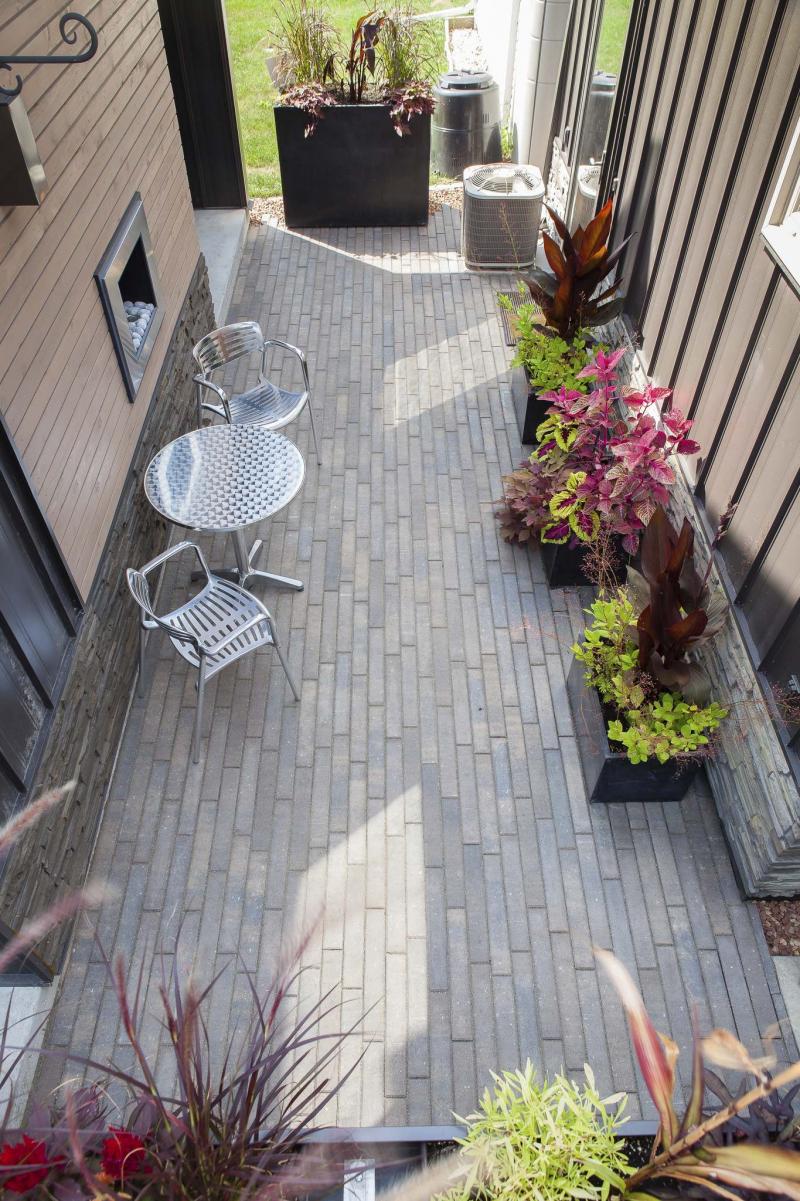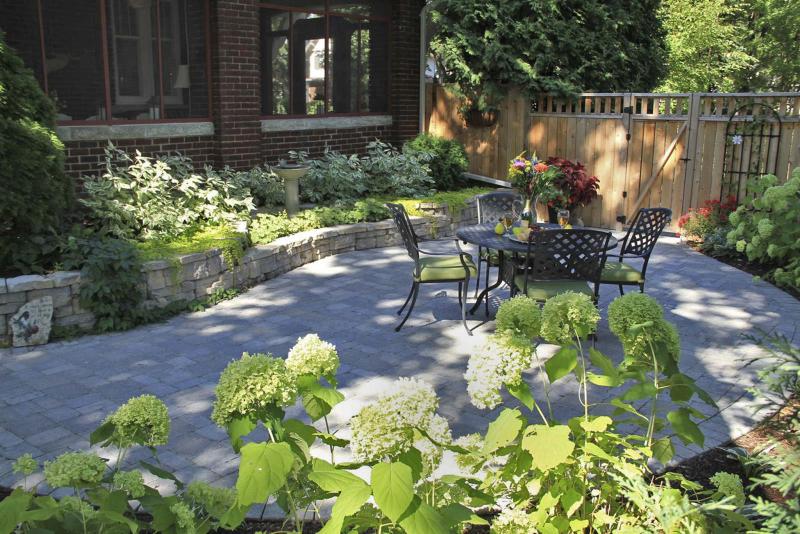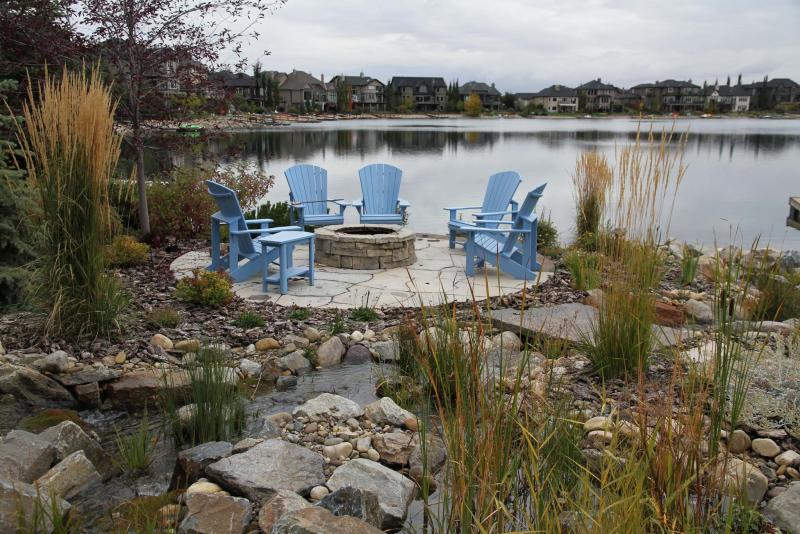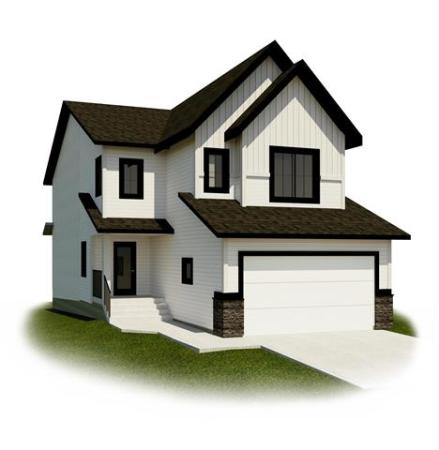
Barkman
With the look of wood and a linear shape, Broadway pavers are the perfect complement to this contemporary space.

Hardscapes
Belvedere Fon du Lac Wall with Roman Sierra Grey pavers in a random pattern.
Paving stones, first used by the Romans in third century BC, have come a long way. Today’s consumer can choose from a greater range of styles and materials than ever before from precast concrete products that mimic hardwood flooring to natural slate, flagstone, and weather-resistant travertine or porcelain tiles.
As awe-inspiring and jaw-droppingly gorgeous as some of the newer options may be, what are we most likely to choose? Roman pavers, a concrete product manufactured by Barkman Concrete, an industry-leading Manitoba-based company, is the surface of choice for more local consumers than any other type of composite material, according to Nick Dueck, product consultant.
What’s the attraction? Easy to install and relatively affordable, the Roman paver has continued to stay relevant since its introduction 10 years ago. Its rectangular shape with tumbled edges has a classic, romantic appearance.
A supplier of Barkman products, Ray DuBois, co-owner of Ron Paul Garden Centre, St. Mary’s Road, testifies to the consistent popularity of Roman pavers. A cloud of dust can often be seen suspended over Ron Paul Garden Centre, typically the scene of front-end loaders and trucks coming and going with pallets of Roman pavers. Still, while it may seem easiest to choose the same paving stone that your neighbour has (although perhaps in a different colour just to be bold), why not let your imagination go wild?
Earlier this spring when I visited the Home and Garden Show at the RBC Convention Centre, my heart fluttered when I stepped onto a paver surface called Bridgewood Slab. With the look and feel of time-worn hardwood in a rich cedar-brown colour, Bridgewood comes in dramatic lengths ranging from 890 millimetres to 440 mm and a width of 250 mm. Also available in weathered grey, Bridgewood pavers have every appearance of barn-wood planks but with the durability of concrete and will never need to be stained, sanded or sealed like wood. Each paver has a thickness of 51 mm.
Dueck says Bridgewood has been the most successful product launch in Barkman’s history. It brings rustic elegance and a cottage-country feel to the outdoor living space. Two other new products, Terra Nova and Broadway, also have the look of wood, but are sleeker and more contemporary with the refinement of indoor hardwood. The linear shapes of these styles of pavers are the perfect complement to contemporary spaces. In one project, says Dueck, Broadway was installed in a narrow space between two buildings for a smashing makeover.
Edges are changing, too. While rounded or serpentine curves or square or rectangular shapes with clean, tailored edges are common depending on preference or the dictates of a specific space, pavers of different lengths can be arranged in an irregular pattern to form a jagged edge. This results in a truly unique look, one that is made to appear as though a patio or pathway flows into or blends with the surrounding natural environment. In one local project, a patio at water’s edge was constructed using Grand Flagstone, a product with the texture and scale of large natural flagstone. Surrounded by rocks, bark and ornamental grasses, the paver harmonizes well.
Mixing materials to create borders or inlays that serve as a focal point helps to accentuate and define a space, says Dueck. "Some people want their patio table, for example, to sit on a section with flagstone," says Dueck. "The effect is that of an area rug, which adds to the intimacy of the outdoor space."
Similar to today’s home exterior colour trends which see the use of darker colours in siding and roof shingles as well as chunky black granite boulders for landscape accents, pavers in darker colours such as charcoal and grey are becoming more popular.
It’s all part of an integrated approach to outdoor living, says DuBois who also provides installation and design services. "Homeowners today are taking a well-thought-out approach to their landscapes," he says, "from the moment the first paver is laid to the conclusion of their outdoor design concept."
Doug Loeppky is a paving stone contractor and owner of Hardscapes Inc. He specializes solely in paving stone and retaining wall installation. Loeppky says that clients are investing more in their landscapes than ever before. "Indeed," says Loeppky, "some projects get pretty expensive -- $50,000 to $100,000."
Often large-scale projects include the addition of walls which are effective at breaking up space in large landscapes, creating a courtyard dynamic and a sense of enclosure. Loeppky says that walls made of stone in multiple sizes and that have a weathered, natural look are more popular now than products such as stack stone which have a very manufactured look and come in only one segment size. Walls are dramatic focal points and used for tiered landscapes, retaining, additional seating, or enclosure. Kodah wall is a new product with a more chiselled, classic stone look than its smaller cousin, Belvedere, says Loeppky.
For patios, Loeppky likes the clean lines of Verano, a Barkman paving stone that is similar to Roman pavers but with smoother edges.
Borgert Products is a Minneapolis-based manufacturer of concrete paving stones and walls that uses granite aggregates in its products rather than limestone. Jeff Vermette, owner of Lawn ‘N’ Order, a local landscape services company, says that granite is less porous than limestone and less likely to stain or discolour from road salts. One product, Vavel stone, has a weathered appearance. Another, the Cobble series, comes in nine different sizes for an endless array of pattern possibilities.
Another product making inroads in the paving stone marketplace is Belgard Hardscapes. Designed and distributed by Expocrete, a North American manufacturing company, Belgard paving stones are locally available at Lacoste Garden Centre and J & D Penner. Generally this product line sells for about 15 to 20 percent more than other paving products.
Lee Hotas, account manager at Expocrete’s office on Chevrier Blvd., says that the main trend he is seeing is in pavers that mimic natural stones. Pavers such as Mega Arbel are typically larger with irregular shapes, textured surfaces and random, natural edges for a mosaic effect. Hotas says that they have false joints. When polymeric sand it put into the indentation, it mimics three or four different stones which equates to quicker installation, he says.
Hotas says not only are colours trending towards more blended colours and darker hues, the colour of polymeric sand has evolved from tan to midnight black.
Mirage outdoor porcelain paver is a product that is finding favour with condo owners for use on balconies and rooftop patios. Similar in beauty to the type of porcelain tiles that are used indoors, Hotas says that Mirage porcelain has excellent resistance to freezing and thawing and can withstand a load of up to 997 kgs. A thinner product (20 mm), it is textured and skid resistant.
What’s on the horizon in the paving industry? Permeable pavers, says Dueck, are widely used in many parts of North America but not yet in Manitoba. An environmentally friendly option, permeable pavers allow stormwater to drain and filter rapidly through the surface and into the ground. In cities such as Vancouver, Montreal, Seattle, Chicago, and Los Angeles, so-called green alley programs promote the use of permeable pavements to reduce stormwater flooding and filter pollutants.
Dueck says that a permeable system is also useful for directing water into a catchbasin and infiltrating it back into the ground. Recently Barkman and Ron Paul Garden Centre teamed up for an installation project using permeable pavers at a local condominium. Now during spring melt, there won’t be any standing water and very little ice buildup on sidewalks during freeze thaw cycles. A current project involves the installation of permeable pavers for a municipal area on Selkirk Avenue. Instead of concrete tree grates, says Dueck, permeable pavers that amalgamate with the rest of the streetscape will direct water to the trees planted in the area.
Choosing the right paving material for your landscape and budget is exciting and momentous. Hiring a professional installer whom you trust helps to relieve anxiety about how the finished project will look and perform. For DIY projects, Ron Paul provides an easy-to-read installation guide on its website.
colleenizacharias@gmail.com
NOTICE: Still Bloomin’ Pembina Active Living (55+) will host a presentation by Dr. Norman Hunter on Backyard Honey Bees. Auction and plant and seed exchange. Admission is $3. Refreshments will be available. June 30 from 1 to 3 p.m. Grace Church, 50 Barnes St.




